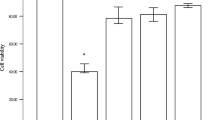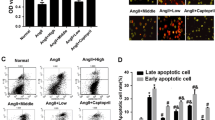Abstract
Background
Anshen Buxin Liuwei pill (ABLP) is a Mongolian medicinal formula that is composed of six medicinal materials: the Mongolian medicine Bos taurus domesticus Gmelin, Choerospondias axillaris (Roxb.) Burtt et Hill, Myristica fragrans Houtt., Eugenia caryophμllata Thunb., Aucklandia lappa Decne., and Liqui dambar formosana Hance. ABLP is considered to have a therapeutic effect on symptoms such as coronary heart disease, angina pectoris, arrhythmia, depression and irritability, palpitation, and shortness of breath.
Methods
H9c2 cardiomyocytes were used to construct a hypoxia/reoxygenation (HR) injury model. CCK-8 assay and Annexin V-FITC cell apoptosis assays were used for cell viability and cell apoptosis determination. The LDH, SOD, MDA, CAT, CK, GSH-Px, Na+-K+-ATPase, and Ca2+-ATPase activities in cells were determined to assess the protective effects of ABLP. The mRNA levels of Sirtuin3 (Sirt3) and Cytochrome C (Cytc) in H9c2 cells were determined by quantitative real-time PCR.
Results
The results indicate that HR-treated cells began to shrink from the spindle in an irregular shape with some floated in the medium. By increasing the therapeutic dose of ABLP (5, 25, and 50 μg/mL), the cells gradually reconverted in a concentration-dependent manner. The release of CK in HR-treated cells was significantly increased, indicating that ABLP exerts a protective effect in H9c2 cells against HR injury and can improve mitochondrial energy metabolism and mitochondrial function integrity. The present study scrutinized the cardioprotective effects of ABLP against HR-induced H9c2 cell injury through antioxidant and mitochondrial pathways.
Conclusions
ABLP could be a promising therapeutic drug for the treatment of myocardial ischemic cardiovascular disease. The results will provide reasonable information for the clinical use of ABLP.
Graphic abstract






Similar content being viewed by others
Data availability
All data included in this study are available upon request by contact with the corresponding author.
References
Thangarasu S, Jeganathan M, Krishna PM (2018) Sinapic acid protects heart against ischemia/reperfusion injury and H9c2 cardiomyoblast cells against oxidative stress. Biochem Biophys Res Comm 456(4):853–859. https://doi.org/10.1016/j.bbrc.2014.12.022
Nie CQ, Ding X, Zheng M (2021) Hydrogen gas inhalation alleviates myocardial ischemia-reperfusion injury by the inhibition of oxidative stress and NLRP3-mediated pyroptosis in rats. Life Sci 272:119248. https://doi.org/10.1016/j.lfs.2021.119248
Tong HY, Zhang SQ, Murtaza G (2019) The present scenario, challenges, and future anticipation of traditional Mongolian medicine in China. World J Tradit Chin Med 5(4):187–192. https://doi.org/10.4103/wjtcm.wjtcm_34_19
Lu JK, Hu YC, Wang LC (2018) Understanding the multitarget pharmacological mechanism of the traditional Mongolian Common herb pair GuangZao-RouDouKou acting on coronary heart disease based on a bioinformatics approach. Evid Based Complement Altern Med. https://doi.org/10.1155/2018/7956503
Shen XN (2021) Clinical effect of Mongolian medicine Anshen-Buxin-Liuwei pill combined with metoprolol succinate sustained release tablets in the treatment of coronary heart disease and angina pectoris. Chin J Ethnomed Ethnopharm 27(01):13–14. https://doi.org/10.16041/j.cnki.cn15-1175.2021.01.008
Okubo S, Ohta T, Fujita H (2020) Costunolide and dehydrocostuslactone from Saussurea lappa root inhibit autophagy in hepatocellular carcinoma cells. Nat Med 75(1):240–245. https://doi.org/10.1007/S11418-020-01462-1
Lu T, Li YP, Hu J (2021) Dexpramipexole attenuates myocardial ischemia/reperfusion injury through upregulation of mitophagy. Eur J Pharmacol 899:173962–173962. https://doi.org/10.1016/J.EJPHAR.2021.173962
Amin MZ, Narges M, Atkin SL (2018) The protective role of curcumin in myocardial ischemia-reperfusion injury. J Cell Physiol 234(1):214–222. https://doi.org/10.1002/jcp.26848
Hausenloy DJ, Yellon DM (2013) Myocardial ischemia-reperfusion injury: a neglected therapeutic target. J Clin Invest 123(1):192–200. https://doi.org/10.1172/JCI62874
Shoji S, Issei K, Masafumi K (2011) Pathophysiology of myocardial reperfusion injury: preconditioning, postconditioning, and translational aspects of protective measures. Am J Physiol Heart Circ Physiol 301(5):H1723–H1741. https://doi.org/10.1152/ajpheart.00553.2011
Jiang HX, Wood KV, Morgan JA (2005) Metabolic engineering of the phenylpropanoid pathway in Saccharomyces cerevisiae. Appl Environ Microbiol 71(6):2962–2969. https://doi.org/10.1128/AEM.71.6.2962-2969.2005
Katarzyna Z, Brandon F, Jordan M (2010) Naringenin, a citrus flavonoid, increases muscle cell glucose uptake via AMPK. Biochem Biophys Res Commun 398(2):178–183. https://doi.org/10.1016/j.bbrc.2010.06.048
Kikuchi K, Tancharoen S, Takeshige N (2013) The efficacy of edaravone (Radicut), a free radical scavenger, for cardiovascular disease. Int J Mol Sci 14(7):13909–13930. https://doi.org/10.3390/ijms140713909
Vishnupriya P, Padma V (2017) A review on the antioxidant and therapeutic potential of Bacopa monnieri. React Oxyg Species. https://doi.org/10.20455/ros.2017.817
Malorni W, Testa U, Rainaldi G (1998) Oxidative stress leads to a rapid alteration of transferrin receptor intravesicular trafficking. Exp Cell Res 241(1):102–116. https://doi.org/10.1006/excr.1998.4020
Cao H, Xu H, Zhu GQ (2017) Isoquercetin ameliorated hypoxia/reoxygenation-induced H9c2 cardiomyocyte apoptosis via a mitochondrial-dependent pathway. Biomed Pharmacother 95:938–943. https://doi.org/10.1016/j.biopha.2017.08.128
Hallows WC, Smith BC, Lee S (2009) Ure(k)a! sirtuins regulate mitochondria. Cell 137(3):404–406. https://doi.org/10.1016/j.cell.2009.04.036
Wu JJ, Yang YL, Gao YF (2020) Melatonin attenuates anoxia/reoxygenation injury by inhibiting excessive mitophagy through the MT2/SIRT3/FoxO3a signaling pathway in H9c2 cells. Drug Des Dev Ther 14:2047–2060. https://doi.org/10.2147/DDDT.S248628
Yi XL, Guo WN, Shi Q (2019) SIRT3-dependent mitochondrial dynamics remodeling contributes to oxidative stress-induced melanocyte degeneration in vitiligo. Theranostics 9(6):1614–1633. https://doi.org/10.7150/thno.30398
Gao JM, Liu S, Xu F (2018) Trilobatin protects against oxidative injury in neuronal PC12 cells through regulating mito-chondrial ROS homeostasis mediated by AMPK/Nrf2/Sirt3 signaling pathway. Front Mol Neurosci 11:267. https://doi.org/10.3389/fnmol.2018.00267
Xiong SP, Sun HJ, Cao L (2019) Stimulation of Na+/K+-ATPase with an antibody against Its 4th extracellular region attenuates angiotensin II-induced H9c2 cardiomyocyte hypertrophy via an AMPK/SIRT3/PPAR-γ signaling pathway. Oxid Med Cell Longev 2019:4616034. https://doi.org/10.1155/2019/4616034
Yin Y, Han W, Cao Y (2019) Association between activities of SOD, MDA and Na+-K+-ATPase in peripheral blood of patients with acute myocardial infarction and the complication of varying degrees of arrhythmia. Hellenic J Cardiol 60(6):366–371. https://doi.org/10.1016/j.hjc.2018.04.003
Chen Z, Jin ZS, Xia Y (2017) The protective effect of lipid emulsion in preventing bupivacaine-induced mitochondrial injury and apoptosis of H9c2 cardiomyocytes. Drug Deliv 24(1):430–436. https://doi.org/10.1080/10717544.2016.1261379
Funding
This work was supported by grants from the National Key R&D Program of China (2018YFC1708206), Research on Identification and Quality Evaluation of Cross-border Traditional Medicine Resources between China and Pakistan (2020E01011), and the Fundamental Research Funds for the Central Universities, South-Central University for Nationalities (CZP20002).
Author information
Authors and Affiliations
Contributions
H‑YT and X-JH contributed to the conception of the study. Y-JH experimented. Y-JH and X-JH contributed significantly to analysis and manuscript preparation. Y-JH and X-JH performed the data analyses and wrote the manuscript. X-CX, YD and MSI helped perform the analysis with constructive discussions.
Corresponding authors
Ethics declarations
Conflict of interest
The authors declare that there are no conflict of interest.
Ethical approval
I testify on behalf of all co-authors that our article submitted to Molecular Biology Reports. All authors: (1) This material has not been published in whole or in part elsewhere; (2) The manuscript is not currently being considered for publication in another journal; (3) All authors have been personally and actively involved in substantive work leading to the manuscript and will hold themselves jointly and individually responsible for its content.
Additional information
Publisher's Note
Springer Nature remains neutral with regard to jurisdictional claims in published maps and institutional affiliations.
Rights and permissions
About this article
Cite this article
Huang, YJ., Tong, H., Huang, X. et al. Anshen-Buxin-Liuwei pill, a Mongolian medicinal formula could alleviate cardiomyocyte hypoxia/reoxygenation injury via mitochondrion pathway. Mol Biol Rep 49, 885–894 (2022). https://doi.org/10.1007/s11033-021-06867-z
Received:
Accepted:
Published:
Issue Date:
DOI: https://doi.org/10.1007/s11033-021-06867-z




